L037—————————————————————————————-
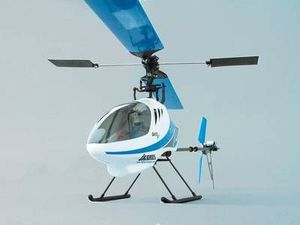
Cheap Positioning System (CPS)
When trying to control a small model helicopter with a computer, one of the main practical problems is to accurately measure the position and orientation in space. The most usual technique is to resort to on-board gyroscope, accelerometer and bi-directional RF-transmitter. However, this may be too heavy and/or expensive for a tiny aircraft and in a “cheap” setting. A different approach consists in mounting laser diodes on the aircraft and to use cameras so as to monitor light dots projected on walls, floor and ceiling. From these positions, the aircraft’s 6 degrees of freedom should be reconstructed. The aim of this project is to implement and compare algorithms for both detection of laser-pointer light dots on walls and estimation of the corresponding angles.
Prerequisite: Interest in programming, some previous knowledge of LabView and/or C is welcome
Professor: Roland Longchamp
Type of project: Semester
Contact: Basile Graf and Philippe Mullhaupt
Student: Philipp Horler
G064—————————————————————————————-
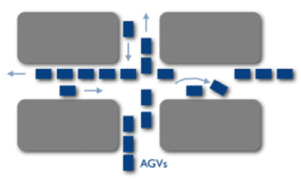
Energy efficient crossing of automated guided vehicles
MER : Denis Gillet
Type : Master
Student: Benjamin Fankhauser
Contact: Laleh Makarem
K004—————————————————————————————-
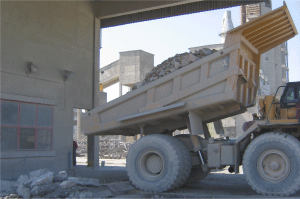
Robust controller design using frequency domain data for industrial processes
Recently a new robust controller design using frequency-domain data has been proposed in Automatic Control Laboratory of EPFL. This method is based on loop- shaping in the Nyquist diagram under infinity norm constraints on closed-loop transfer functions. The aim of this project is to apply this method to two industrial processes. In the first step, the method is used for auto-tuning of PI controllers of condensing boilers and in the second step it will be used for designing a MIMO blending controller for a cement plant.
- The aim of the first part is to develop an algorithm capable of automatically adjusting the parameters of the existing PI controller. The Auto-tune algorithm will be implemented on LabView to control the lab test bench implementing the most relevant boiler working conditions. The control parameter values will then be written to the boiler electronic control board (via a serial port) and tests will be made to validate the results. If time permits, it is also possible to evaluate other control structures than simply PI control. This project is done in close collaboration with Honeywell Combustion Controls in Oggiono (LC), Italy.
- In the second part,
a MIMO blending controller of four input material feeders based on X-ray fluorescence (XRF) or Prompt Gamma Neutron Activation (PGNA) measurements will be designed. The goal of such a controller is to continuously control the raw mix quality, a set of three nonlinear functions of the raw mix oxide composition, at a desired value or to drive the raw mix quality to a desired value at silo filling (batch control). The controlled system exhibits linear dynamics with transport and measurement delays and infrequent noisy measurements. The controller needs to efficiently reject perturbations from the varying input material compositions, while considering bounds on the feeder proportions (input saturations), temporary feeder stops, and bumpless switch between manual and automatic mode.
The controllers will be de tested in simulation in Matlab. A model of the plant will be provided by Online Control Ltd.
MER: Alireza Karimi
Type of project: Master
Student: Vinicius de Oliveira
Contact: Michael Amrhein
K010—————————————————————————————-
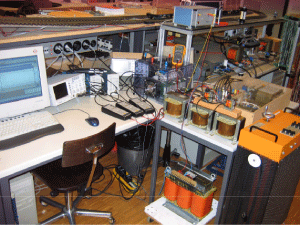
Current control of voltage source converters
The main objective of this project is to develop a new dq current control scheme for single and three-phase voltage source converters (VSCs), which can be adopted in numerous applications, e.g., power exchange between a distributed generated unit and the main grid, power filters, islanding detection, and etc.
Recently, a new approach for robust controller design for multivariable systems by convex optimization has been proposed in Laboratoire d’Automatique, which can be applied to dq current control of VSCs. In this project, the student is expected to:
1-Tailor the proposed method of Laboratoire d’Automatique for the current regulation of VSCs.
2- Evaluate the performance of the proposed method and compare it to that of other existing methods.
3- Experimentally evaluate the performance of the proposed method based on the existing setup in the Laboratoire d’Électronique Industrielle.
It should be noted that it is a joint project between Laboratoire d’Automatique and Laboratoire d’Électronique Industrielle. The theory part is expected to be fulfilled in relation with both labs while the experimental part will be done in Laboratoire d’Électronique Industrielle.
MER: Alireza Karimi
Type of project: Master
Student: Benoit Rey
Contact: Alireza Karimi and Behrooz Bahrani
K005—————————————————————————————-
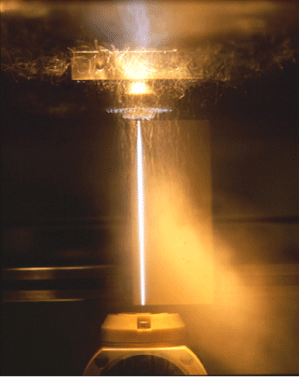
Electrode wear compensation in electric discharge machining
Electric Discharge Machining (EDM) is a widespread technique for processing electrically conductive hard materials. During this process the erosion arises through melting and evaporation mechanisms produced by spark plasmas, which are created between a wire electrode and the workpiece.
In Micro EDM milling, electrode wear needs to be compensated for by position control of the vertical axis. Therefore, an accurate estimation of the electrode length is required. In a recent project carried out in LA, it has been shown that the vibration modes of a wire electrode can be estimated from the operating data. This information could also be used to determine the electrode length.
The objective of this project is to quantify electrode wear by using the operating data or by developing a model. The most promising option is to be investigated. A controller compensating for the wear should be computed and implemented.
This project is carried out in collaboration with in Geneva.
MER: Alireza Karimi
Type of project: Master
Student: Etienne Schafer
Assistant: Alain Bock
B036—————————————————————————————–
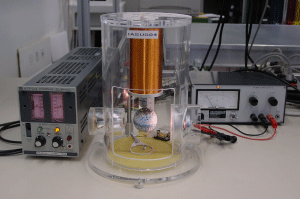
Nonlinear control of a magnetic levitation system
The project aims at developing a controller using the quotient method for a magnetic levitation system. The quotient method works well for a certain class of nonlinear systems known as “feedback-linearizable system”. Since the magnetic levitation system does not fall in this class of system, it requires approximation while designing a control law using the quotient method. The student is required to model the system, design a control law for the system using the quotient method and compare the results with existing linear and nonlinear control laws available in the literature.
Professor: Dominique Bonvin
Type of project: Semester
Student: Patrik Clerc
Contact: Willson Shibani and Philippe Müllhaupt
L036—————————————————————————————-
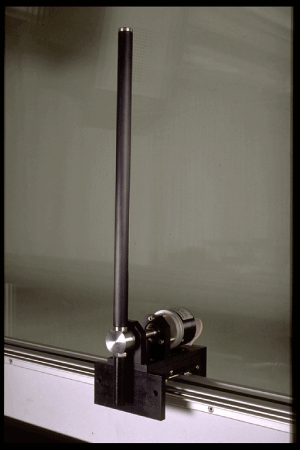
Identification of friction for an inverted pendulum
Static friction is present on many mechanical systems and is hard to model because of it’s nonlinearity. The Laboratoire d’Automatique has a system which is subject to such friction : The inverted pendulum on a cart. The presence of friction makes it difficult for controllers to bring the cart back to the origin when the pendulum is up, because the input becomes too low to overcome the friction. Having a model of such friction is of great value because it would allow one to comput a nonlinear controller.
This project aims to identify and model this friction. Then incorporating the friction into the dynamic model, a controller is to be developed and implemented.
Professor : Roland Longchamp
Type of project: Semester
Student: Frédéric Blanc
Contact: David Ingram and Philippe Mullhaupt
G057—————————————————————————————
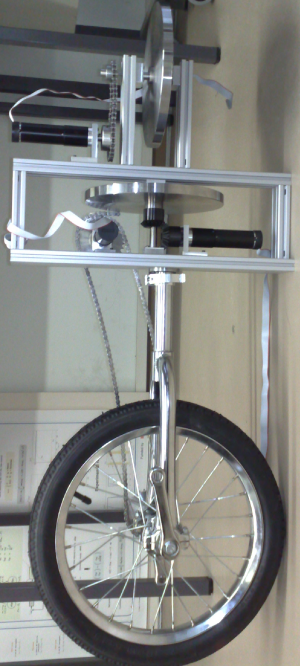
Control of an autonomous unicycle robot
The Laboratoire d’Automatique is developing an autonomous unicycle robot for educational purpose. The system is supposed to stay on vertical position on its single wheel and move along paths. Preliminary studies have been performed in previous projects both in simulation and on a first prototype.
The goal of this project is to improve the design for achieving full energetically autonomy and to implement a controller able to follow predefined paths.
MER : Denis Gillet
Type of project: Semester
Student: Philippe Dreyer
Contact: David Ingram and Alain Bock
K006—————————————————————————————-
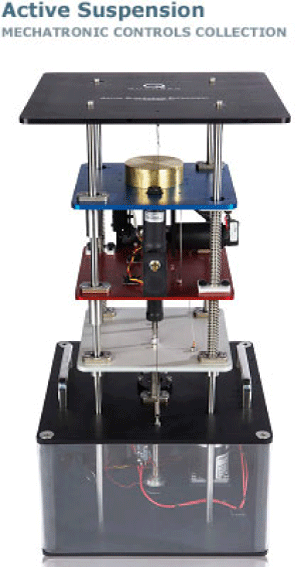
Identification and control of an active suspension system
The aim of this project is design of a controller for an active suspension system. The controller will be tested on an experimental platform. The platform consists of three floors (plates) on top of each other. The top and the middle plates are connected with two springs and a tunable damper, and also with DC motor which serves as an actuator for active suspension. The bottom plate represents road and serves as a source of vibrations of top plate which are measured by accelerometer (acceleration relative to platform ground). The objective of the project is to identify the model of the system and compute a controller to reject vibrations with narrow-band time-varying frequency. The controller design is based on the identified nonparametric models and gain-scheduling approach developed in the Automatic Control Laboratory of EPFL.
MER: Alireza Karimi
Type of project: Semester
Student: Jakob Baader
Contact: Zlatko Emedji
B034—————————————————————————————–
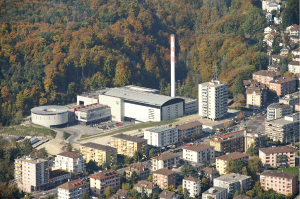
Modeling and control of overheated steam production in urban waste inceneration
Tridel is a company located in Lausanne that processes urban waste of 144 cities and villages in the Canton de Vaud. Up to 160’000 t/year of waste is burnt in two furnaces, and the generated heat is used to produce overheated steam. Most of this steam is valorized as thermal energy for remote heating of private houses in Lausanne, while the rest drives a turbine to generate electricity.
This project is concerned with the modeling and control of the overheated steam production system. This system consists of a series of 4 heat exchangers. Two injections of liquid water are performed, between the second and the third stage and between the third and the fourth stage, to control the exit temperature through cascaded control loops. The steam production system is designed such that the two injection valves work at comparable openings. However, it might happen in practice that temperature control is achieved mostly by the first valve, with the second valve being nearly closed. This behavior is undesired, since the opening and closing of the second valve at very low opening induces oscillations in the pressure profile. This project aims at building a dynamic simulation model and investigating possible reasons for the observed behavior. Furthermore, it is proposed to study the sensitivity of the load distribution between the two valves in terms of certain parameters of the control loops.
Professor: Dominique Bonvin
Type of project: Semester
Student: Fernando Trairetirado
Contact: Gregory Francois and Sean Costello
K001—————————————————————————————-
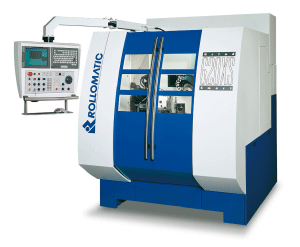
Adaptive correction of geometry evolution of a grinding machine
Machine tools need more and more to be precise and to have a reliable production. Based on the design, engineers try to make them as much as possible autonomous and independent from external disturbances.
The goal of this project is to develop a new approach to improve the accuracy of a grinding machine with 6 numerical axes designed for complex tools made of hard materials.This machine has its own measuring system made up of 3 linear absolute encoders. The geometry of this machine is defined by references which can be measured in order to study their evolution. Therefore, they describe the geometrical changes of the machine depending on the internal and external disturbances, mainly due to the temperature variation.
The main objectives of the project are as follows:
- Analysis of the measurements of the geometry evolution for a grinding machine.
- Identification of an ARMA filter with n-step ahead prediction based on the measurements.
- Developing a recursive algorithm for adaptive estimation of the parameters of the ARMA filter.
- Identification of an ARMAX model for the system with ambient temperature as input.
The student will use the identification toolbox of Matlab for simulation and other softwares for real-time implementation.
This project is carried out in collaboration with Rollomatic SA in Switzerland.
MER: Alireza Karimi
Type of project: Semester
Student: Junfeng Lu
K009—————————————————————————————-
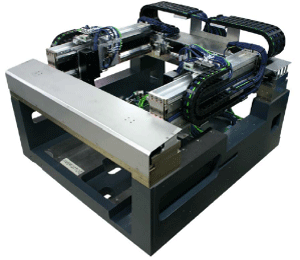
Frequency-domain identification of a dual-drive gantry system
A dual-drive gantry configuration is a mechanical solution which offers higher acceleration levels in positioning systems. In such systems, two parallel linear motors are derived with the same reference signal and their positions are controlled independently. However, because of the mechanical coupling between two drives, high performance can be achieved when two drives are perfectly synchronized. This can be achieved by a multivariable controller in which the off-diagonal controllers decouple the system outputs.
The objective of this project is to identify a multivariable nonparametric model for a dual-drive gantry system. Some results from a master projects are available. These results should be improved to find more accurate models at low frequencies. The students should visit ETEL a few times for data acquisition.
The project is proposed in collaboration with the Swiss company, ETEL.
MER: Alireza Karimi
Type of project: Semester
Student: Mohamed Ghassen Belkhiria
B039—————————————————————————————-

Nonlinear control of a magnetic levitation system
This project aims at implementing the quotient-method controller for a test setup of an active suspension system. Generally, a suspension is designed in order to minimize the vertical acceleration of the car body for passenger comfort. In normal cars, this is achieved by using a spring and a damper. However, these components are passive and have limited capabilities. The idea of feedback suspension systems is to put an active component (like a hydraulic or pneumatic cylinder or a linear motor) in parallel to the usual passive components and control it using feedback. Outputs available for computing the feedback law are suspension length and acceleration of the car body. The scope of this project is to (i) develop an appropriate quarter-car model, (ii) design an observer to estimate the states from the measured outputs, and finally (iii) tune and implement a quotient-method controller on a test setup using LabView.
Professor: Dominique Bonvin
Type of project: Semester
Student: Killian Daly
Contact: Willson Shibani and Philippe Müllhaupt
B040—————————————————————————————

Modeling and control of overheated steam production in urban waste inceneration
Tridel is a company located in Lausanne that processes urban waste of 144 cities and villages in the Canton de Vaud. Up to 160’000 t/year of waste is burnt in two furnaces, and the generated heat is used to produce overheated steam. Most of this steam is valorized as thermal energy for remote heating of private houses in Lausanne, while the rest drives a turbine to generate electricity.
This project deals with modeling and optimization of the energy distribution stage. The overheated steam obtained at the output of the furnaces can be either (i) stored into high, medium and low pressure tanks before being sent to heat exchangers and used to heat up water, or (ii) sent to the turbine. Since it is thermodynamically more interesting to produce hot water than electricity, the main objective is to meet the customer requirements for hot water at a prescribed temperature. On the other hand, the steam flow rate through the turbine needs to be sufficient to ensure proper turbine operation and produce the electricity needs of the factory. Hence, a compromise is sought between these two objectives. For this purpose, a model of the energy distribution system will be built and validated. Then, for different steam flow rates, the model will help set the pressure levels in the storage tanks in order to maximize energy utilization.
Professor: Dominique Bonvin
Type of project: Semester
Student: Sylvain Granges
Contact: Gregory Francois and Sean Costello